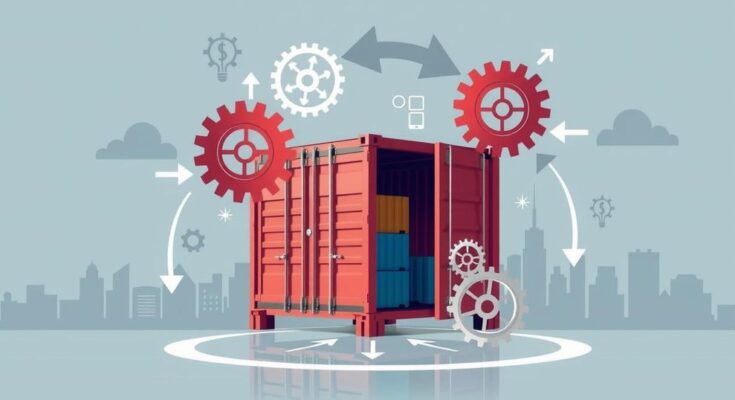President Trump’s proposed tariffs on Mexico, Canada, and China are controversial moves aimed at leveraging trade negotiations while risking inflation and disruption to the global economy. Tariffs function as import taxes that are ultimately paid by consumers. Historically used to protect domestic industry, the outcomes of such policies often lead to price increases and potential retaliations from trading partners, complicating their effectiveness.
The proposed trade tariffs on Mexico, Canada, and China by President Donald Trump mark an assertive stance against the United States’ three primary trading partners. This strategy, while intended to strengthen American negotiating power, comes with the risk of inflation spikes and potential upheaval in the global economy. President Trump stated, “You see the power of the tariff. Nobody can compete with us because we have by far the biggest piggy bank.” Support among the electorate for such tariffs remains divided.
Trump’s tariffs aim to encourage negotiations over issues such as illegal immigration and fentanyl trafficking. The financial markets reacted negatively by dropping the S&P 500 index when the news broke. As businesses face rising import costs due to tariffs, consumers are likely to see increased prices on various goods, particularly those imported from Mexico and Canada, with anticipated tariff rates of up to 25% and 10%, respectively.
Understanding tariffs, which are essentially import taxes, is critical. The U.S. tariffs are meant to deter imports by increasing their costs; they are collected by Customs and Border Protection at ports of entry. Tariff rates vary based on the product, and those from countries with trade agreements, such as Mexico and Canada, may often enter duty-free under the USMCA. However, the complexity of these tariffs leads to increased costs for American importers who subsequently pass them on to consumers.
While President Trump claims that tariffs will not harm American consumers, evidence suggests that the cost burden falls on them. According to various economic studies, the real impact of tariffs translates to higher prices for consumer goods. For instance, economists predict tariffs on Chinese goods will cost the average U.S. household thousands annually, with potential increases of up to $7,600 in yearly expenses due to these tariffs.
Products such as toys, furniture, and household items may face significant price hikes. Estimates suggest that toys from China could see price increases of up to 56%. Meanwhile, goods from Mexico, including cars and avocados, will also likely experience cost increases due to tariff policies.
Historically, tariffs have served both as a revenue source and a regulatory measure to protect domestic producers. However, their application has significantly decreased since the post-World War II era. Today, tariffs comprise a relatively small portion of federal revenue compared to income taxes. Despite this, President Trump’s administration leverages tariffs not just for economic reasons but also as a tool to influence foreign policy, including immigration control.
The potential for retaliation from other countries significantly complicates the efficacy of tariffs. Neighboring countries may impose counter-tariffs that could exacerbate the economic impact on American exports. Studies have indicated that tariffs may not achieve intended job protection objectives and could lead to adverse employment outcomes, particularly in agricultural sectors affected by retaliation.
Furthermore, analyses suggest that Trump’s tariffs could lead to inflationary pressures, increasing living costs for consumers. Predictions estimate inflation could rise by as much as 0.5 percentage points due to these tariffs. The price of gasoline, largely dependent on imports from Canada, could also increase without exemptions in tariff policies.
The topic of President Trump’s planned tariffs on three main trading partners—Mexico, Canada, and China—highlights the administration’s pivot towards protective trade policies aimed at reshaping international negotiations. This approach emerges amidst concerns over illegal immigration and drug smuggling, generating potential repercussions in both pricing for consumers and the broader economic landscape. Historically, tariffs have fluctuated as a primary source of federal revenue and a means to shield local industries, yet their modern application sees complexity influenced by the global trade network. Tariffs function as taxes imposed on imports, serving as a mechanism to control foreign competition. Introducing tariffs can safeguard domestic industries, yet they often carry an inflationary burden for consumers and lead to retaliation from affected trading partners, disrupting established trade relations.
In conclusion, President Trump’s imposing tariffs on Mexico, Canada, and China signal a shift towards protectionism with broad implications for consumer prices and the global economy. While intended to leverage better trade negotiations, these tariffs pose risks of inflation and increased costs across various consumer products. The evolution of trade policies reflects historical trends alongside contemporary economic challenges. Understanding the balance between protective measures and the repercussions on consumers remains critical to navigating the current trade landscape.
Original Source: www.nbcchicago.com




